They communicate with each other. Send out pheromones when stressed. Adapt to the environment. Care for their children. Live in community. Breathe.
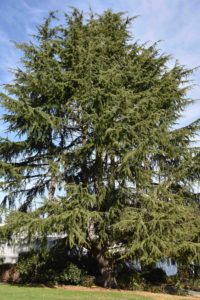
No, we’re not talking animals here, or humans. We’re talking trees – those giants who include the oldest, heaviest and tallest living beings on the planet, and about whom science is constantly making startling discoveries. Best-selling books like Peter Wohlleben’s “Hidden Life of Trees” and David Haskell’s “The Song of Trees” have woken us up to the fact that trees aren’t just visual wallpaper, but individual beings who sense and react to their environment, just like we do.
Here at Point Defiance Zoo & Aquarium, we’re lucky to have a landscape full of these incredible beings. Not only do they give shelter, shade and food for animals (like our browse garden), they transport us to every corner of the globe, showing the diversity of habitat for the wildlife we protect.
And nobody knows our trees better than Bryon Jones, lead horticulturalist, who gives garden tours every month. Here are some of his favorite trees.
Corkscrew willow – communicating danger
Salix matsudana ‘Tortuosa’
The name says it all – those tortured, twisted branches spiraling up and out of a dense crown. Humans love it for its quirky beauty, especially in winter. Animals like our beavers and porcupines love chewing on its wood, while the leaves are a favorite browse for elephants. But willows – native to China – also have the ability to communicate with each other, sending out airborne chemicals when under insect attack to warn nearby willows. All the willows will then produce a substance that makes their leaves harder for bugs to digest.
FIND OURS: Behind the gift shop near the front gate.
Giant sequoia – age, majesty and carbon storage
Sequoiadendron giganteum
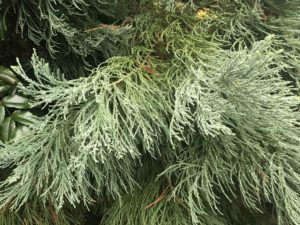
Also known as the giant redwood, this is North America’s tree of legend. The most massive trees on Earth, giant sequoias are only found naturally in California’s western Sierra Nevada mountains – but they fit perfectly with the towering cedars and firs of Point Defiance Park. Ours is only around 25 years old, so it still has a lot of growing to do (the tallest sequoia is 274 feet, and the oldest known is 3,500 years old.) Animals rely on sequoia forests for habitat, and humans are inspired by their majesty.
But old trees like sequoias are also vital for protecting our world from climate change.
“They take in and store carbon dioxide over hundreds of years,” explains Jones. “Forests are one of the biggest carbon sinks on our planet, keeping those gases from trapping heat in the atmosphere. They’re essential.”
FIND OURS: Behind the carousel near Gate 2 (accessible on tour only) and near Wild Wonders Outdoor Theater.
Southern magnolia – breathing through bark
Magnolia grandiflora
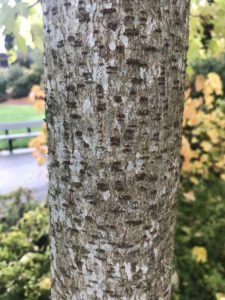
What’s really fascinating, though, is their trunks, dotted with lenticels (small brownish spots) that allow the tree to exchange gasses in and out – in essence, breathing. (Other Zoo trees with visible lenticels include the cherry and the ligiri just downhill from the grassy lawn.)
FIND OURS: Throughout the Zoo but especially near Red Wolf Woods.
Paperbark maple – flying seeds
Acer griseum
Making a trio with the giant sequoia and an Alaskan cedar, our paperbark maple is the perfect example of this gorgeous tree: dagger-shaped leaves and copper-toned bark that peels off in big curls. Native to China, this maple (like all maples) gives its seeds tiny wings to help them fly far from the shade of their parent.
FIND OURS: Behind the carousel near Gate 2 (accessible on tour only).
Coral bark maple – not just a pretty face
Acer palmatum ‘Sango kaku’
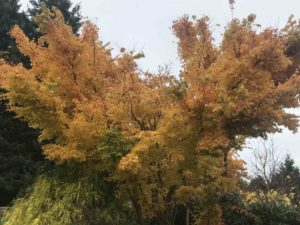
It’s easy to spot a coral bark maple in fall: a swathe of golden-orange leaves reaching like fingers atop a pink trunk. A type of Japanese maple, the coral bark does look a bit like coral on a reef, which is why gardeners love it.
But a maple is not just a pretty face. Like all trees everywhere, they use underground fungi networks to communicate with each other. Ecologist Suzanne Simard, of the University of British Columbia, discovered in 1997 that forest trees exchanged nutrients, carbon and water via the fungi’s mycelium threads. They send extra resources to trees in need, or to feed offspring. Like us, trees live in community.
FIND OURS: Halfway down the stairs from the main plaza.
Quaking aspen – the largest living thing
Populus tremuloides
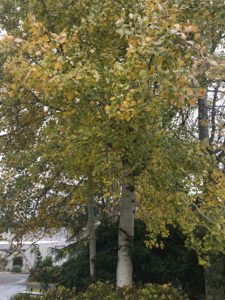
They look like eight quaking aspen trees, just below the grassy hub lawn. At this time of year their leaves quiver like a mosaic of gold. But actually, they’re just one organism with many above-ground eruptions.
A deciduous North American native, quaking aspen grow in dense stands connected by a single root system. Years ago, the Zoo only had three trunks in this area. Jones cleared the soil above the root and notched them to encourage extra shoots – with excellent results. Unlike most trees, aspens can photosynthesize through their white bark, making sugar year-round. They offer habitat and food for deer, moose and elk, and humans use them for paper, furniture and pet bedding.
What’s astonishing, though, is the sheer mass of this giant.
“They’ve measured a grove in Utah and discovered it’s the largest known living thing on Earth,” says Jones. That grove has nearly 50,000 stems, covers 100 acres and weighs 6,000 tons, according to the National Wildlife Federation. Says Jones: “That makes a blue whale look tiny.”
FIND OURS: Just downhill from the grassy lawn near the Earth Station kiosk.
Deodar cedar – bulking up against the weather
Cedrus deodara
Jones often includes the Zoo’s majestic deodar cedar in his tree tours, and not just because of its impressive size and shape.
“Cedar is one of the trees that can change its wood in reaction to wind and snow, or to support extra weight or damaged areas,” he says. “On the underside of a branch it produces compression wood to support the extra weight, like a hand holding it up. You can see that, it’s thicker. Other trees like oak and maple grow tension wood on the top of the branch: it’s springier and can flex to pull up the branch. It’s amazing that trees can sense and react to their surroundings, just like we do.”
FIND OURS: On the path just above the Wild Wonders Outdoor Theater.
Wollemi pine – back from extinction
Wollemia
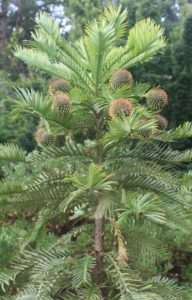
One of Jones’ tree stops is a 12-foot conifer with enormous cone balls. With light green, widely spaced needles and oddly sparse branches it’s the odd man out at the Washington evergreen party. It’s a Wollemi pine, rediscovered by an Australian bushwalker in 1994 after being thought extinct forever.
An ancient conifer in the Araucariaceae family, the Wollemi pine was thought to exist only in the fossil record, which dated the tree back 200 million years to the early Jurassic. After living trees were discovered in a remote area of the Wollemi National Park near Sydney, horticulturalists have carefully begun to cultivate the pine – and Point Defiance Zoo has not one but four.
“It’s pretty rare to find them around here,” says Jones, modestly. “And ours are apparently some of the largest in the area.”
FIND OURS: One tree is off the path to the right of Kids’ Zone; another is in the bed sloping down from the old aquarium to Wild Wonders Outdoor Theater; a third is between Penguin Point and Wild Wonders.
Urban individuals
So why come to a zoo just to look at trees?
“I do this tour to celebrate trees as themselves, not just as habitat and food for animals and people,” says Jones. “Trees are living individuals with unique abilities, just like people.”
And Jones’ favorite tree?
“The monkey puzzle, for sure,” he says, of the tall South American tree with long, spiky branches. “It’s so bizarre-looking, and it’s one of the most endangered in the world. And of course, everyone loves the big one near our plaza – it’s the Seahawks tree during Zoolights.”